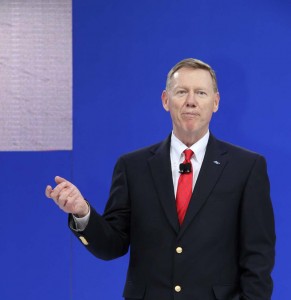
Ford CEO Alan Mulally will return to CES in January - though keynote duties will go to Daimler's Chairman Dieter Zetsche.
While the words, “consumer electronics,” are likely to bring to mind an iPhone or widescreen TV, the auto industry is becoming a more and more powerful force in the field as motorists search for technology that will keep them informed and entertained while driving.
That convergence was underscored, in recent years, by Alan Mulally’s three-peat appearance as the keynote speaker at the annual Consumer Electronics Show, held each January in Las Vegas. The largest trade show in the country will once again turn to a member of the auto industry as keynoter for 2012, but this time to Daimler AG Chairman and Mercedes-Benz boss Dieter Zetsche. Mulally will be back in Sin City, however, as a member of one of the annual event’s opening panels.
“Convergence is real,” said Gary Shapiro, president of the Consumer Electronics Association, sponsor of CES, which is expected to draw at least 2,000 exhibitors and 150,000 attendees to Las Vegas next January. “Innovation,” he stressed, is critical to both the automotive and electronics industries because “growth comes only from innovation.”
For the upcoming show, 400 auto-related companies – including at least 32 from Michigan — will exhibit at CES. And the event will see a growing number of auto manufacturers from around the world including not only Ford and Mercedes but Chrysler, Audi, Kia and General Motors – along with its high-tech arm, OnStar.
Appearing at CES is “an opportunity to not only redefine our company but the overall industry,” said Ford’s telematics and technology chief Paul Mascarenas. “It helps us walk away from that image of being part of the rust belt.”
Past automotive exhibitors included Hyundai and Toyota, the Japanese maker last year winning an award for its new telematics system, InTune.
“There’s a double-digit growth in the automotive area every year except for 2009,” when the industry went into its worst slump since the Great Depression, noted Shapiro.
The market for automotive electronics is huge. In terms of after-market sales alone the figure will approach $9 billion this year, according to CES data. And that doesn’t include the extensive use of electronic components in the typical automobile. On average, that runs several thousand dollars, though for some high-end products that can top $20,000.
Most major automakers have begun offering in-car telematics systems that either use proprietary links to the outside world, link up through a motorist’s cellphone or use both technologies. That allows products like Toyota’s InTune and Ford’s Sync to offer an array of services, including the ability to stream music from Internet-based providers like Pandora.
“Technology is the enabler that creates the experience,” said Mascarenas, adding that this is a critical area of differentiation between brands.
That’s not to say there aren’t plenty of challenges. Cost is always an issue, though as with the broader consumer electronics industry prices for many of the new onboard technologies continue to fall. That means systems once available only on high-line products are now showing up in the mainstream.
To spur the development of onboard electronics, the industry is showing an unusual level of cooperation between erstwhile competitors, stressed Ford’s Mascarenas. That can impact everything from the plugs used to charge electric vehicles to the software standards used for the hands-free Bluetooth system.
“We don’t want everyone developing different solutions,” he explains. “There’d be chaos.”
